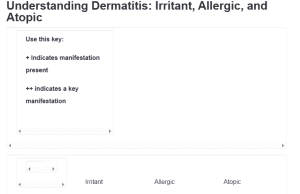Understanding Dermatitis: Irritant, Allergic, and Atopic
|
Type of Dermatitis |
Irritant | Allergic | Atopic | ||
| General manifestations
|
|||||
| Pain | + | + | |||
| Pruritus | + | ++ | ++ | ||
| Xerosis | ++ | ||||
| Erythema | ++ | + | + | ||
| Edema | ++ | ||||
| Appearance immediately after exposure | ++ | ||||
| Delay of manifestation after exposure | ++ | ||||
| Vesicles | ++ | ||||
| Papules | + | ++ | |||
| Crusting | + | ||||
| Lichenification | ++ | ||||
| Fissuring | + | ++ | |||
| Well-demarcated lesions | ++ | + | |||
| Lesions confined to one area | ++ | + | |||
| Lesions affecting multiple areas | ++ | ||||
Understanding Dermatitis: Irritant, Allergic, and Atopic
Irritant, allergic, and atopic dermatitis have overlapping symptoms, but each type has distinct characteristics that aid in diagnosis. Irritant dermatitis results from direct exposure to a harmful substance, such as chemicals or detergents, which damages the skin barrier. It typically presents immediately after contact, causing pain (+), erythema (++), and well-demarcated lesions (++) localized to the site of exposure. These lesions remain confined to one area (++) and do not spread unless the exposure is widespread or prolonged. This type of dermatitis is common in occupational settings where harsh substances frequently contact the skin.
Allergic dermatitis is an immune-mediated reaction to allergens with a delayed onset of symptoms. Key manifestations include pruritus (++), edema (++), and vesicles (++), often followed by crusting (+) and papules (+). These vesicles may rupture, leading to further skin irritation. Unlike irritant dermatitis, allergic dermatitis can spread beyond the site of initial contact, sometimes affecting multiple areas (+). The delayed reaction (++) and widespread distribution make it crucial to identify and avoid the triggering allergen to prevent recurrence (Tramontana et al., 2023). It is often seen in individuals exposed to plants, metals, or chemicals, which trigger an allergic response.
Atopic dermatitis, a chronic inflammatory skin condition, is associated with a personal or family history of allergies, asthma, or hay fever. It is marked by xerosis (++), severe pruritus (++), and lichenification (++), which occurs from chronic scratching. Lesions often affect multiple areas (++), particularly in the flexural regions. In atopic dermatitis, the skin’s ability to retain moisture is compromised, leading to fissuring (++) and further irritation (Fishbein et al., 2020). Atopic dermatitis can significantly impact the quality of life due to its chronic nature and the intense itching experienced by patients.
References
Fishbein, A. B., Silverberg, J. I., Wilson, E. J., & Ong, P. Y. (2020). Update on atopic dermatitis: Diagnosis, severity assessment, and treatment selection. The Journal of Allergy and Clinical Immunology: In Practice, 8(1), 91–101. https://doi.org/10.1016/j.jaip.2019.06.044
Tramontana, M., Hansel, K., Bianchi, L., Sensini, C., Malatesta, N., & Stingeni, L. (2023). Advancing the understanding of allergic contact dermatitis: From pathophysiology to novel therapeutic approaches. Frontiers in Medicine, 10(79). https://doi.org/10.3389/fmed.2023.1184289
ORDER A PLAGIARISM-FREE PAPER HERE
We’ll write everything from scratch
Question
Instructions
Week 9 Case Study
Directions
All students should complete the chart here. When learning skin disorders, it is important to note how different diagnoses/conditions appear on different skin tones. Note: All case studies are provided learning tool for students who wish to have them as a learning tool.
Irritant, allergic, and atopic dermatitis have similar clinical manifestations. Recognizing similarities and differences may aid in determining diagnosis. In this activity, determine whether the manifestations listed are present in irritant, allergic, or atopic dermatitis and identify the key manifestations for each dermatitis. The manifestations may be present in more than one type of dermatitis.
Type of Dermatitis Irritant Allergic Atopic
General manifestations
Pain
Pruritus
Xerosis
Erythema
Edema
Appearance immediately
after exposure
Delay of manifestation
after exposure
Vesicles
Papules
Crusting

Understanding Dermatitis Irritant, Allergic, and Atopic
Fissuring
Well–demarcated lesions
Lesions confined to one
area
Lesions affecting multiple
areas

